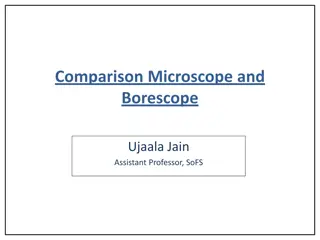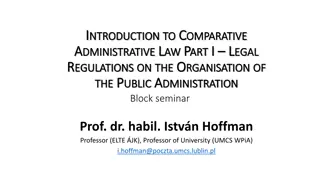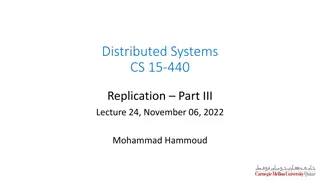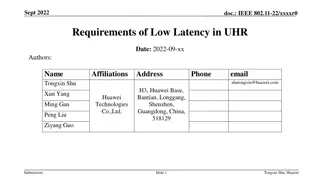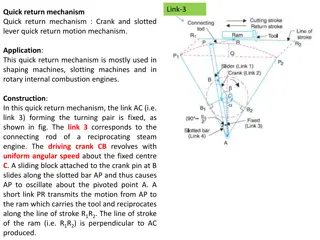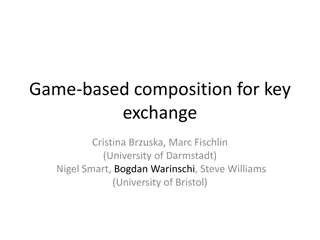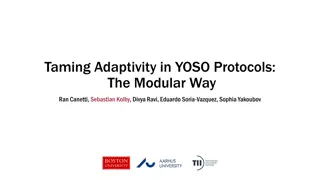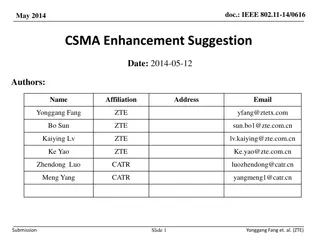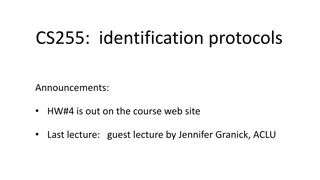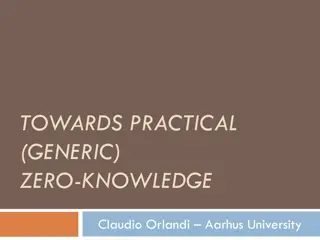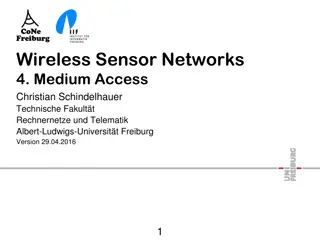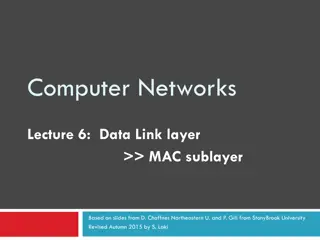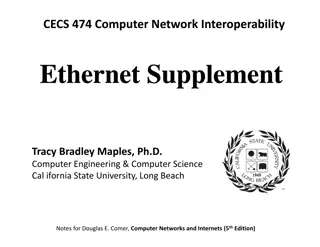Comparison of ALOHA, Slotted ALOHA, and CSMA Protocols
ALOHA is a basic protocol where stations can transmit at any time, which leads to collisions. Slotted ALOHA organizes time into slots to reduce collisions and increase efficiency. CSMA uses carrier sensing to avoid collisions. Each protocol has its advantages and limitations in handling network traffic and maximizing channel utilization.
Download Presentation

Please find below an Image/Link to download the presentation.
The content on the website is provided AS IS for your information and personal use only. It may not be sold, licensed, or shared on other websites without obtaining consent from the author.If you encounter any issues during the download, it is possible that the publisher has removed the file from their server.
You are allowed to download the files provided on this website for personal or commercial use, subject to the condition that they are used lawfully. All files are the property of their respective owners.
The content on the website is provided AS IS for your information and personal use only. It may not be sold, licensed, or shared on other websites without obtaining consent from the author.
E N D
Presentation Transcript
ALOHA ALOHA = a protocol for packet radio networks ( shared medium ) A station may transmit a frame any time. The station then listens for an amount of time equalto the maximum possible round-trip propagation delay on the network(twice thetime it takes to send a frame between the two most widely separated stations) plusa small fixed time increment. If the station hears an acknowledgment during thattime, fine; otherwise, it resends the frame. If the station fails to receive an acknowledgmentafter repeated transmissions, it gives up. A receiving station determinesthe correctness of an incoming frame by examining a frame check sequence field. If the frame is valid and if the destination address in the frame header matches the receiver s address, the station immediately sends an acknowledgment. The frame may be invalid due to noise on the channel or because another stationtransmitted a frame at about the same time. In the latter case, the two frames mayinterfere with each other at the receiver so that neither gets through; this is knownas a collision. If a received frame is determined to be invalid, the receiving stationsimply ignores the frame. Because the number of collisions rises rapidly with increased load, the maximum utilization of the channelis only about 18%.
frame Slotted ALOHA 1 time slot = 1 frame Slot 1 Slot 2 Slot 3 Slot 4 To improve efficiency, a modification of ALOHA, known as slotted ALOHA, was developed. In this scheme, time on the channel is organized into uniform slots whose size equals the frame transmission time. Some central clock or other technique is needed to synchronize all stations. Transmission is permitted to begin only at a slot boundary. Thus, frames that do overlap will do so totally. This increases the maximum utilization of the system to about 37%. Both ALOHA and slotted ALOHA exhibit poor utilization. Both fail to take advantage of one of the key properties of both packet radio networks and LANs, which is that propagation delay between stations may be very small compared to frame transmission time. Consider the following observations. If the station-to-station propagation time is large compared to the frame transmission time, then, after a station launches a frame, it will be a long time before other stations know about it. During that time, one of the other stations may transmit a frame; the two frames may interfere with each other and neither gets through. Indeed, if the distances are great enough, many stations may begin transmitting, one after the other, and none of their frames get through unscathed. Suppose, however, that the propagation time is small compared to frame transmission time. In that case, when a station launches a frame, all the other stations know it almost immediately. So, if they had any sense, they would not try transmitting until the first station was done. Collisions would be rare because they would occur only when two stations began to transmit almost simultaneously. ALOHA propagation time frame ( ) CSMA
Carrier Sense Multiple Access (CSMA) With CSMA, a station wishing to transmit first listens to the medium to determine if another transmission is in progress (carrier sense). If the medium is in use, the station must wait. If the medium is idle, the station may transmit. It may happen that two or more stations attempt to transmit at about the same time. If this happens, there will be a collision; the data from both transmissions will be garbled and not received successfully. To account for this, a station waits a reasonable amount of time after transmitting for an acknowledgment, taking into account the maximum round-trip propagation delay and the fact that the acknowledging station must also contend for the channel to respond. If there is no acknowledgment, the station assumes that a collision has occurred and retransmits. One can see how this strategy would be effective for networks in which the average frame transmission time is much longer than the propagation time. Collisions can occur only when more than one user begins transmitting within a short time interval (the period of the propagation delay). If a station begins to transmit a frame, and there are no collisions during the time it takes for the leading edge of the packet to propagate to the farthest station, then there will be no collision for this frame because all other stations are now aware of the transmission.
CSMA if the medium is busy Non-persistent algorithm 1-persistent algorithm p-persistent algorithm CD CD CD n p 1 n station!!!
CSMA-CD (with Collision Detection) CSMA, although more efficient than ALOHA or slotted ALOHA, still has one glaring inefficiency. When two frames collide, the medium remains unusable for the duration of transmission of both damaged frames. For long frames, compared to propagation time, the amount of wasted capacity can be considerable. This waste can be reduced if a station continues to listen to the medium while transmitting. This leads to the following rules for CSMA/CD:
C collision C The amount of time that it takes to detect a collision is no greater than twice the end-to-end propagation delay. A collision A
Binary Exponential Backoff CSMA-CD 1-persistent algorithm 1. collision frame propagation time 2. collision Binary Exponential Backoff IEEE 802.3 and Ethernet use a technique known as binary exponential backoff. A station will attempt to transmit repeatedly in the face of repeated collisions. For the first 10 retransmission attempts, the mean value of the random delay is doubled. This mean value then remains the same for 6 additional attempts. After 16 unsuccessful attempts, the station gives up and reports an error. The beauty of the 1-persistent algorithm with binary exponential backoff is that it is efficient over a wide range of loads. At low loads, 1-persistence guarantees that a station can seize the channel as soon as it goes idle, in contrast to the non- and p- persistent schemes. At high loads, it is at least as stable as the other techniques. However, one unfortunate effect of the backoff algorithm is that it has a last-in first-out effect; stations with no or few collisions will have a chance to transmit before stations that have waited longer. LAN (Ethernet) !!!
Cable Length (limited by CD) For baseband bus, a collision should produce substantially higher voltage swings than those produced by a single transmitter. Accordingly, the IEEE standard dictates that the transmitter will detect a collision if the signal on the cable at the transmitter tap point exceeds the maximum that could be produced by the transmitter alone. Because a transmitted signal attenuates as it propagates, there is a potential problem: If two stations far apart are transmitting, each station will receive a greatly attenuated signal from the other. The signal strength could be so small that when it is added to the transmitted signal at the transmitter tap point, the combined signal does not exceed the CD threshold. For this reason, among others, the IEEE standard restrictsthe maximum length of coaxial cable to 500 m for 10BASE5 and 200 m for 10BASE2. Switch Hub collision 1. half duplex 2. Collision !!!
repeater propagation time CSMA/CD(/) local area network full-duplex switch collision repeater CSMA/CD switch station





